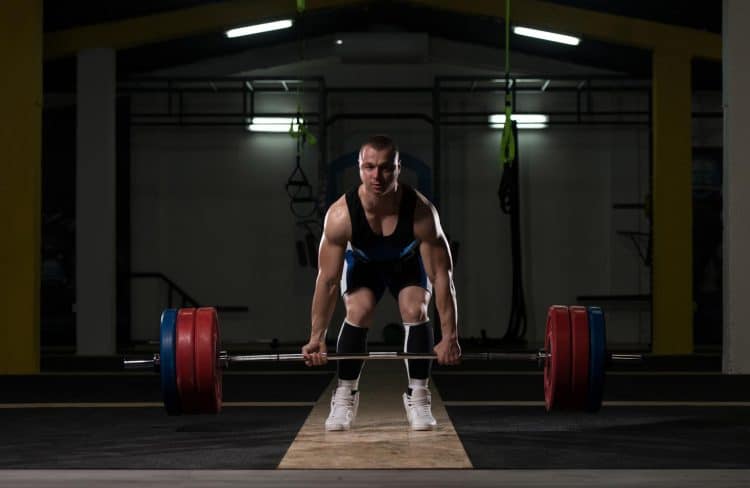Whether you’re a powerlifter, bodybuilder, or simply want to get swole, the deadlift should be a staple movement for you. Given that this is such a taxing exercise, most experts recommend deadlifting no more than twice per week.
Yet, a few years ago, a guy named Daniel McKim popularized a program called ‘Deadcember.’ Following on from ‘Squatober,’ it involves deadlifting every day for a month and doing it in the month of December.
As a veteran personal trainer who’s been ingraining the importance of rest and recovery in my clients for 30+ years, my initial reaction was, ‘That’s not a good idea.’ Still, with a few of my clients wanting to take on the challenge, I decided to put aside my initial skepticism and do a deep dive into the subject.
Read on to find out whether taking on the Deadcember challenge is something that should be on your ‘to-do’ list.
Define Your Goal
The first question to ask yourself when you’re weighing up whether to jump into a deadlifting daily for a month program is, ‘What is my training goal?’
Level Up Your Fitness: Join our 💪 strong community in Fitness Volt Newsletter. Get daily inspiration, expert-backed workouts, nutrition tips, the latest in strength sports, and the support you need to reach your goals. Subscribe for free!
Or, to put it more simply, are you a bodybuilder or a powerlifter?
In my experience, many trainers don’t know the answer to this fundamental question. As a result, they follow a shotgun approach that combines frequencies, set, and rep ranges that simply don’t make sense.
If your goal for going to the gym is to make your body bigger, stronger, and leaner, then you’re in the bodybuilding category. It doesn’t matter that you don’t ever plan to step on a bodybuilding stage.
Bodybuilders use the deadlift as a tool to build muscle. That is completely different from powerlifting, where the exercise is the goal. It’s all about how much weight you can lift with proper form.
So, which one are you?
If you’re a bodybuilder, then you should not deadlift every day.
You are deadlifting to make your lats, traps, glutes, hamstrings, and lower back bigger and stronger. Yet, when you walk out of the gym, those muscles are weaker due to the stress you’ve put on them.
If you’ve worked them hard enough, the target muscles will actually have micro tears in their fibers. What they need now is rest and protein. These will stimulate muscle protein synthesis by which the muscle damage is repaired and made slightly bigger and stronger.
If you were to go into the gym the next day and start deadlifting again, you’d be throwing a spanner into the works as far as your recovery process is concerned. By sabotaging the recovery process, you’ll negate your hard work from the previous day.
You don’t want to do that!
A 2016 meta-study by Brad Schoenfield examined ten previous studies on training frequency. These studies had participants working out from once per week to three times per week. Brad’s analysis showed that a frequency of two to three times per week is ideal for muscle growth. [1]
In other words, if your goal is to add mass to your body, you need at least a day’s recovery between working each muscle group. That makes deadlifting daily out of the question.
Deadlifting Daily for Powerlifting Gains
Deadlifting daily shouldn’t be part of your normal powerlifting practice.
Even though your goal is not to build muscle, you still need to moderate your frequency to allow for muscle recovery. If you don’t, you’ll end up overtraining, and your strength gains will stagnate.
However, there is merit in mixing things up occasionally.
Deadlifting daily is as much a mental as it is a physical challenge. You’ll discover things about yourself that you never knew. You’ll build resilience and persistence as you push through those days when deadlifting is the last thing you want to do.
Doing the deadlift for a month challenge with a partner, or a group of buddies, will make it more enjoyable.
Benefits of Deadlifting Daily for a Month
- Technique development: If you are just learning the deadlift, doing it every day for a month will help ingrain the technique. If this is the case for you, use a load that is around 50% of your one rep max until you are confident with your form, and then switch to the program detailed at the end of this article.
- Plateau Buster: If you’ve been stuck on a weight that you just can’t get beyond for several months, you could probably benefit from a shake-up. Deadlift daily could be just what it takes to shock your body into renewed strength gains.
- Challenge aspect: We all love a good challenge. It can motivate us to dig deeper than we thought we were capable of. Add in the social media aspect of programs like the Deadcember challenge, and you could just have the perfect recipe to finish the year on a deadlift high.
Drawbacks of Deadlifting Daily for a Month
- Time-consuming: Unless you do your deadlifts at home, you’re going to have to get your butt to the gym every single day to complete this challenge. That can be a problem, especially on the weekends. In fact, you may find that getting to and from the gym takes longer than your actual deadlift workout.
- Increased Injury Risk: When done properly, a daily deadlift program will regulate volume and load to avoid overtraining. However, you can’t avoid a degree of cumulative fatigue. This may result in poor form, especially towards the end of the week when you’re lifting your heaviest. Poor form increases injury risk.
- Negative Impact on your Overall Program: If you deadlift every day, you will obviously be deadlifting on the same days that you’re squatting and bench pressing. Do your DLs first, and you may negatively impact the exercises to follow. Do them last, and your squatting or benching work may rob you of strength.
Will Deadlifting Daily For a Month Make You Stronger?
Deadlifting daily for a month can definitely make you stronger. I’ve known powerlifters who have increased their one-rep max by as much as 20 pounds after completing the Deadcember challenge.
By the same token, I know at least one guy whose max deadlift actually went down after deadlifting for 31 days in a row.
It all comes down to how you do it.
The key to making deadlift gains comes down to two factors:
- Volume
- Intensity
Volume refers to the total amount of work you do. It is a calculation of the number of sets x the number of reps x the weight lifted.
Volume = Sets x Reps x Weight
Intensity refers to the percentage of your one rep max you are lifting.
Level Up Your Fitness: Join our 💪 strong community in Fitness Volt Newsletter. Get daily inspiration, expert-backed workouts, nutrition tips, the latest in strength sports, and the support you need to reach your goals. Subscribe for free!
Frequency, or how many times per week you do the exercise, is not a major factor. That means that, as long as you’re hitting the ideal volume and intensity, it doesn’t matter whether you’re deadlifting once or seven times per week.
So, what is the ideal volume and intensity to increase your deadlift?
Unfortunately, there is no definitive answer to that question. You will have to experiment to develop your sweet spot balance between under-training and overtraining, where you gain continual strength.
As a former gym owner and trainer of powerlifters since the 1980s, I’ve got a pretty good idea of what that ‘sweet spot’ looks like for most people. As a result, I can provide you with a general template. It’s then up to you to give it a trial run and adapt it to maximize your own benefits.
Sample Deadlifting Frequency and Intensity
What follows are the deadlifting total sets, reps, and intensities that I have found work best, based on training dozens of competitive powerlifters over the past 30 years.
These figures are for a 7-day period. They do not include warm-up sets.
- Four sets of 5 reps @60% of IRM
- Four sets of 3 reps @65% of IRM
- Four sets of 3 reps @70% of IRM
- Four sets of 3 reps @75% of IRM
- Three sets of 3 reps @85% of IRM
- Five sets of 1 rep @90% of IRM
That is a total of 24 sets. As I explained earlier, it doesn’t really matter whether those sets are done in one or seven sessions. So long as the total volume and intensity are the same, you will, theoretically, achieve similar results.
Of course, cumulative fatigue would play a part if you tried to do 24 sets of deadlifts in one session, culminating with five sets of 90%. So, I don’t recommend doing that. I typically program two sessions per week, with 10-12 sets in each session.
Calculate your one rep max deadlift.
Factoring in RPE
Another factor to consider is the rate of perceived exertion or RPE. This scale of one to ten describes how hard an exercise should feel. Here’s a chart that breaks it down:
| RPE | Description |
| 1 | Very easy, minimal effort |
| 2 | Easy, minimal effort |
| 3 | Moderate, still relatively easy |
| 4 | Moderate, comfortable |
| 5 | Challenging but manageable |
| 6 | Challenging, becoming difficult |
| 7 | Difficult, somewhat of a struggle |
| 8 | Very difficult, noticeably challenging |
| 9 | Extremely difficult, almost maximal |
| 10 | Maximal effort, unable to continue |
When you are doing the deadlift every day, it is important that you monitor your RPE. This will help to avoid burnout and overtraining, allowing you to periodize your intensity.
Here is how you should match your RPE to the weekly volume and intensity described in the previous section:
- Four sets of 5 reps @60% of IRM – RPM = 6
- Four sets of 3 reps @65% of IRM – RPM = 7
- Four sets of 3 reps @70% of IRM – RPM = 8
- Four sets of 3 reps @75% of IRM – RPM = 8
- Three sets of 3 reps @85% of IRM – RPM = 8
- Five sets of 1 rep @90% of IRM – RPM = 9
Adding a Deadlift Variation
If I were to develop a deadlift daily for a month program, I would include a deadlift variation one day per week. This has the obvious benefit of injecting some variety into the program. Depending on the variation chosen, it also helps to develop accessory muscle groups and focus on specific aspects of the deadlift movement.
My two favorite deadlift variations are the rack deadlift and the trap bar deadlift.
Trap Bar Deadlift
Deadlifting every day may cause some lower back pain. By swapping in the trap bar deadlift, you are able to perform the exercise in a more upright position. This reduces the stress on your erector spinae, giving your lower back some much-needed relief.
The trap bar deadlift also activates the quadriceps more than the regular barbell version of the exercise. The stronger your quads are, the more power you’ll be able to generate through the initial pulling phase.
The trap bar deadlift’s neutral grip will also relieve your forearms and wrists.
Rack Pull Deadlift
The rack pull deadlift is a partial range of motion version of the standard deadlift performed inside a power rack. It is an effective way to strengthen the lockout phase of the exercise.
Because you are starting with the bar at a higher than standard position, you’re able to use a heavier weight than in a standard deadlift. As a result, you will become stronger in the top half of the movement.
Sample Deadlift Daily for a Month Program
Having accounted for volume, intensity, RPE, and deadlift variations, we can now lay out a sample deadlift daily for a month …
Week One
| Mon | Tues | Wed | Thurs | Fri | Sat | Sun |
| Four sets of 5 reps @60% of IRM – RPM = 6 | Four sets of 3 reps @65% of IRM – RPM = 7 | Four sets of 3 reps @70% of IRM – RPM = 8 | Four sets of 3 reps @75% of IRM – RPM = 8 | Three sets of 3 reps @85% of IRM – RPM = 8 | Five sets of 1 rep @90% of IRM – RPM = 9 | Rack Pull DL &
Trap Bar DL: 3 x 5 reps @ 65% IRM each |
Week Two
| Mon | Tues | Wed | Thurs | Fri | Sat | Sun |
| Four sets of 5 reps @60% of IRM – RPM = 6 | Four sets of 3 reps @65% of IRM – RPM = 7 | Four sets of 3 reps @70% of IRM – RPM = 8 | Four sets of 3 reps @75% of IRM – RPM = 8 | Five sets of 1 rep @90% of IRM – RPM = 9 | Rack Pull DL &
Trap Bar DL: 3 x 5 reps @ 65% IRM each |
1 set of 1 rep @ 90%
1 set of 1 rep @ 100% Retest 1RM |
Adjust weights based on new 1RM
Week Three
| Mon | Tues | Wed | Thurs | Fri | Sat | Sun |
| Four sets of 5 reps @60% of IRM – RPM = 6 | Four sets of 3 reps @65% of IRM – RPM = 7 | Four sets of 3 reps @70% of IRM – RPM = 8 | Four sets of 3 reps @75% of IRM – RPM = 8 | Three sets of 3 reps @85% of IRM – RPM = 8 | Five sets of 1 rep @90% of IRM – RPM = 9 | Rack Pull DL &
Trap Bar DL: 3 x 5 reps @ 65% IRM each |
Week Four
| Mon | Tues | Wed | Thurs | Fri | Sat | Sun |
| Four sets of 5 reps @60% of IRM – RPM = 6 | Four sets of 3 reps @65% of IRM – RPM = 7 | Four sets of 3 reps @70% of IRM – RPM = 8 | Four sets of 3 reps @75% of IRM – RPM = 8 | Five sets of 1 rep @90% of IRM – RPM = 9 | Rack Pull DL &
Trap Bar DL: 3 x 5 reps @ 65% IRM each |
1 set of 1 rep @ 90%
1 set of 1 rep @ 100% Retest 1RM |
Wrap-Up
Deadlifting daily for a month isn’t for everybody. If your main reason for working out is to add muscle mass to your body, then you should not be taking on this challenge. It will prevent your muscles from sufficiently recovering between workouts, preventing you from making the gains your hard work deserves.
If you aim to haul as much weight as possible from the floor, then deadlifting daily for a month can be a useful addition to your program. But only if it’s done correctly.
A deadlifting daily program should be utilized infrequently (no more than twice per year), using a volume and intensity that aligns with what you typically use. Stagger your rate of perceived exertion and percentages of 1RM to ensure constant progression rather than burnout.
References
- Schoenfeld BJ, Ogborn D, Krieger JW. Effects of Resistance Training Frequency on Measures of Muscle Hypertrophy: A Systematic Review and Meta-Analysis. Sports Med. 2016 Nov;46(11):1689-1697. doi: 10.1007/s40279-016-0543-8. PMID: 27102172.











